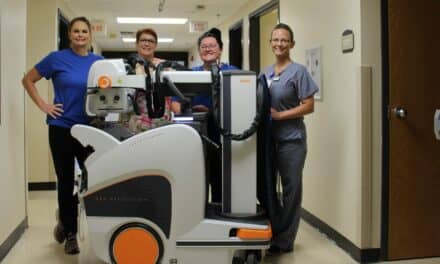Patients will literally be at the center of the x-ray experience at Salt Lake City’s University of Utah Health Care, thanks to the hospital’s installation of Siemens Healthineers’ Multitom Rax Twin Robotic X-ray system. The installation, which marks the first in the United States, enables University of Utah Health Care patients to lie down or stand while the Multitom Rax’s two independent, ceiling-mounted robotic arms for the x-ray tube head and the flat-panel detector capture images around them.
The system’s two robotic arms can be moved automatically or by staff, who can use servo motor support to make fine adjustments. Capturing static, dynamic, and real 3D sequences, the Multitom Rax enables, for the first time, the acquisition of 3D images under the patient’s natural weight-bearing condition—whether seated, lying down, or standing. Images acquired in the natural standing position are essential because the knees, pelvis, and spinal column appear differently when the patient’s body weight is applied compared to when the patient is lying down, Siemens officials say.
“Patients are expected to benefit the most from this new Multitom Rax system because it allows our physicians to perform a much broader array of clinical imaging applications in a single imaging room without ever having to move the patient,” says Satoshi Minoshima, MD, PhD, professor and chair of the department of radiology and imaging sciences at the University of Utah.
“We are very excited to be the first facility in the U.S. to explore the Multitom Rax’s potential for efficiency and productivity,” he adds.
For more information about this system, visit Siemens Healthineers.




